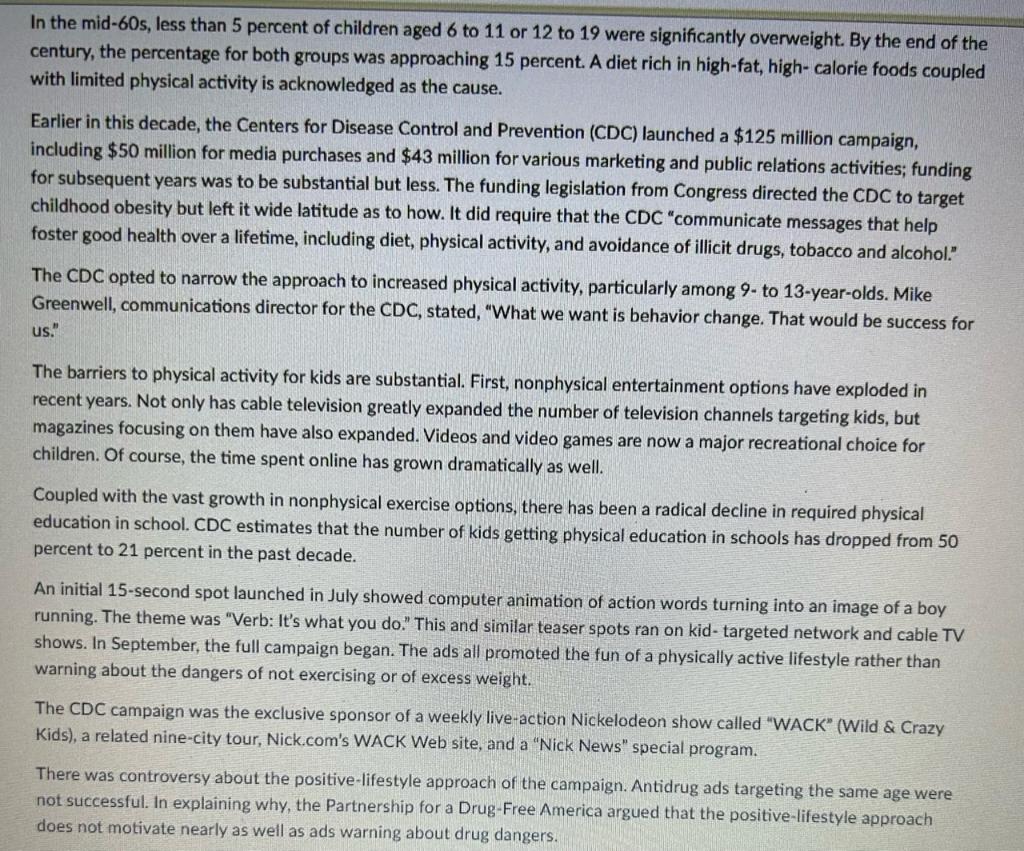Question
The campaign focused primarily on children, with limited attention to parents. Teachers and other potential influencers were not directly targeted. What do you think is

The campaign focused primarily on children, with limited attention to parents. Teachers and other potential influencers were not directly targeted. What do you think is the appropriate balance among these groups? Why?
Is the positive approach better than the negative approach in this situation? Why?
Describe a series of three positive-lifestyle ads you would use to encourage physical activity among 9- to 13-year-olds.
Describe a series of three warning ads you would use to encourage physical activity among 9- to 13-year-olds.
Describe a series of three positive-lifestyle ads targeting parents that you would use to encourage physical activity among their 9- to 13-year-old
Describe a series of three warning ads targeting parents that you would use to encourage physical activity among their 9- to 13-year-old children.
*****Use creativity with your ads (questions 3 - 6). Single spaced. Do NOT restate the question. Provide question number and then provide answer. Pictures can be used for ads, words/hashtags, etc for the ads.
In the mid-60s, less than 5 percent of children aged 6 to 11 or 12 to 19 were significantly overweight. By the end of the century, the percentage for both groups was approaching 15 percent. A diet rich in high-fat, high-calorie foods coupled with limited physical activity is acknowledged as the cause. Earlier in this decade, the Centers for Disease Control and Prevention (CDC) launched a $125 million campaign, including $50 million for media purchases and $43 million for various marketing and public relations activities; funding for subsequent years was to be substantial but less. The funding legislation from Congress directed the CDC to target childhood obesity but left it wide latitude as to how. It did require that the CDC "communicate messages that help foster good health over a lifetime, including diet, physical activity, and avoidance of illicit drugs, tobacco and alcohol." The CDC opted to narrow the approach to increased physical activity, particularly among 9-to 13-year-olds. Mike Greenwell, communications director for the CDC, stated, "What we want is behavior change. That would be success for us. The barriers to physical activity for kids are substantial. First, nonphysical entertainment options have exploded in recent years. Not only has cable television greatly expanded the number of television channels targeting kids, but magazines focusing on them have also expanded. Videos and video games are now a major recreational choice for children. Of course, the time spent online has grown dramatically as well. Coupled with the vast growth in nonphysical exercise options, there has been a radical decline in required physical education in school. CDC estimates that the number of kids getting physical education in schools has dropped from 50 percent to 21 percent in the past decade. An initial 15-second spot launched in July showed computer animation of action words turning into an image of a boy running. The theme was "Verb: It's what you do." This and similar teaser spots ran on kid-targeted network and cable TV shows. In September, the full campaign began. The ads all promoted the fun of a physically active lifestyle rather than warning about the dangers of not exercising or of excess weight. The CDC campaign was the exclusive sponsor of a weekly live-action Nickelodeon show called "WACK" (Wild \& Crazy Kids), a related nine-city tour, Nick.com's WACK Web site, and a "Nick News" special program. There was controversy about the positive-lifestyle approach of the campaign. Antidrug ads targeting the same age were not successful. In explaining why, the Partnership for a Drug-Free America argued that the positive-lifestyle approach does not motivate nearly as well as ads warning about drug daneersStep by Step Solution
There are 3 Steps involved in it
Step: 1

Get Instant Access to Expert-Tailored Solutions
See step-by-step solutions with expert insights and AI powered tools for academic success
Step: 2

Step: 3

Ace Your Homework with AI
Get the answers you need in no time with our AI-driven, step-by-step assistance
Get Started


